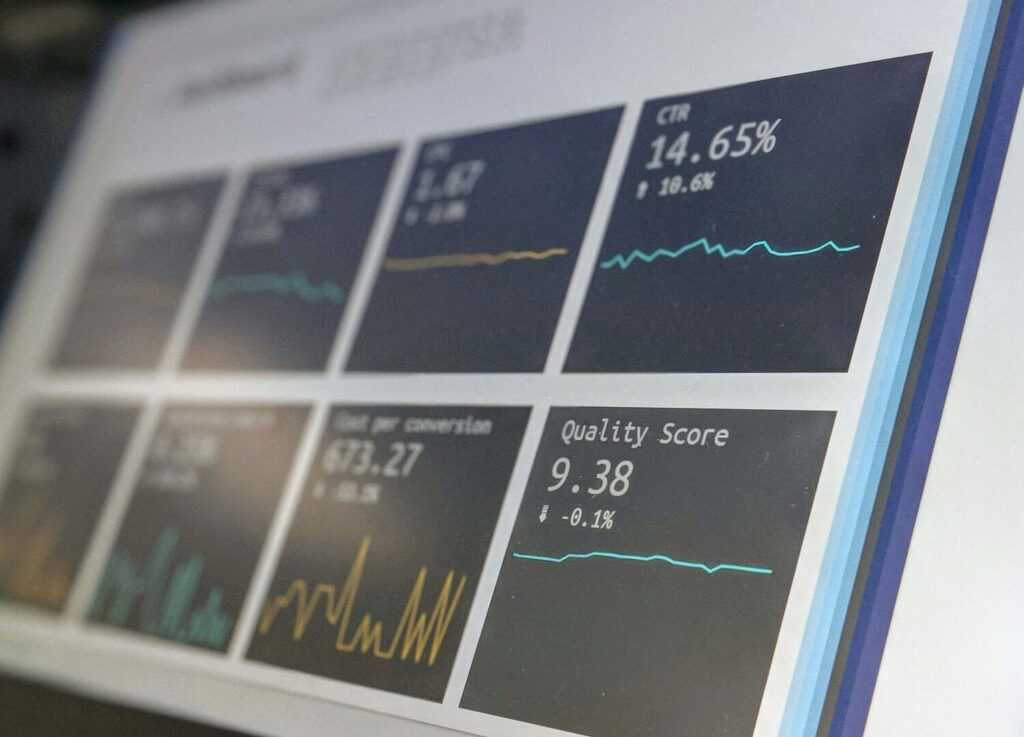Are you having trouble getting your website to rank on Google? You’re not alone. Many business owners struggle with this issue. It’s no secret that in order to rank high on Google, your website needs to have high-quality content. In-fact we found studies and statistics that shows that content over 3,000 words wins 3x more traffic, 4x more shares, and 3.5x more backlinks than average-length content (around 1,400 words)
But what if you’re doing everything right and your website still isn’t ranking? If you’ve ever found yourself wondering, “What are the reasons why my website is not ranking?”—you’re in the right place.
In this blog post, we’ll dive into sixteen Reasons Why My Website Is Not Ranking and what you can do about each one!
16 Reasons why your website may not be ranking
If you’re scratching your head wondering why your website isn’t ranking as high as you’d like, there could be a number of reasons.

Here are 16 potential explanations:
1. Ineffective Keyword Research
Many factors play into website ranking, and it can be challenging to keep track of all the elements that impact search engine optimization (SEO). However, one of the most important pieces of the puzzle is keyword research.
In order to rank high in search results, your website needs to include content that is relevant to the terms people are searching for. That’s why keyword research is an essential first step in any SEO strategy.
By using tools like Google AdWords Keyword Planner, you can identify the keywords that are most likely to result in website traffic.
Start by identifying seed keywords related to your niche, then use a tool to find long-tail keywords with decent search volume and low competition.
SEO Guru – Neil Patel notes “Keyword research is the cornerstone of any SEO campaign. Without keyword research, you won’t know which keywords your target audience searches for, which ones have search intent that matches your business, which ones are feasible for you to target, and what you need to do to rank for them.”
2. Subpar Content Quality
Thin, outdated, or keyword-stuffed content won’t cut it in 2025. Google’s E-E-A-T guidelines (Experience, Expertise, Authoritativeness, Trustworthiness) demand content that truly serves users.
For this discussion, Let us take a tech blog with 300-word posts that skim the surface—they’ll struggle against competitors offering 2,000-word guides packed with insights and case studies.
To rank higher, create in-depth, user-focused content. Research top-ranking pages for your target keyword, then craft comprehensive articles (1,500+ words) with visuals, stats, and expert insights.
According to Velocity, high-quality content generally leads to higher search engine rankings as wells as the quality of your content is known as its “quality score,” or QS for short.
Simply put, a high QS means Google thinks your writing is better than other sites’ writing about similar topics–and that makes it more likely that people will click through and read what you’ve got to say on your website.

3. Outdated SEO tactics
One reason your website may not be ranking as highly as you’d like could be that you’re using outdated SEO tactics. Search engine algorithms are constantly changing, and what worked last year may not work this year.
For example, keyword stuffing – packing a web page with so many keywords that it’s difficult to read – used to be an effective way to improve search engine rankings.
But now, Google penalizes sites that use this technique, so it’s actually doing more harm than good. If you’re not sure whether your SEO tactics are up-to-date, it’s a good idea to consult with an expert. Staying current on the latest SEO trends will help ensure that your website is able to rank well in search results.
4. Duplicate content
One common reason why websites may not be ranking highly on search engines is duplicate content. This occurs when there is more than one version of a piece of content online, often because it has been copied from another source.
This can be a problem because search engines may view the duplicate content as less relevant and thus lower in the search results.
Additionally, duplicate content can also make it difficult for search engines to index a website properly, further hurting its ranking. To avoid these problems, it is essential to make sure that all the content on your website is unique.
To catch it, start by running your site through Siteliner, which scans for internal duplicates and flags pages with similar text. For external duplicates, paste your page URLs into Copyscape to check if your content appears elsewhere online.
Next, head to Google Search Console and check the “Coverage” report for crawl or canonical issues that might signal duplicate problems. For a quick manual check, copy a unique sentence from your page, pop it into Google in quotes, and see if it shows up on other sites.
These steps, using tools like Siteliner and Copyscape, help you spot duplicates fast so you can rewrite content or add canonical tags to set things straight.

5. Slow Website Speed
Website speed is important for two reasons. First, users are less likely to continue engaging with a site that takes too long to load; in fact, according to some studies, a delay of just one second can result in a significant drop-off in web traffic.
Second, and perhaps more importantly, Google puts a great deal of emphasis on site speed when it comes to ranking results in its search engine. A 2023 case study showed an eCommerce site losing 18% of conversions due to a 5-second load time.
To speed things up, test your site with Google PageSpeed Insights, compress images using TinyPNG, and enable browser caching with a Content Delivery Network (CDN).
This means that if your website is slow, it’s unlikely to appear as prominently in search results as faster sites, which could have a major impact on your business.
6. Bad links
One crucial factor that search engines take into account when ranking websites is the quality of the links pointing to that site. Links from high-quality websites indicate to search engines that your site is also authoritative and trustworthy.
Conversely, links from low-quality or spammy websites can hurt your ranking. In addition, link networks, groups of websites that all link to each other, are often penalized by search engines because they are often used for spamming purposes. Read more about building how to build back links and what to avoid.
As a result, it’s important to be careful about the quality of the links you include on your website and to avoid being part of a link network. If you’re not sure whether a link is helping or hurting your website’s ranking, you can always ask a professional SEO consultant for help.

7. Poor Mobile Usability
In today’s world, an ever-increasing number of people are using their mobile devices to access the internet. In fact, recent studies show that over 63.38% of all internet traffic now comes from smartphones and tablets.
This trend is only likely to continue, which means that it’s more important than ever for websites to have a mobile-friendly interface. If your website is not optimized for mobile devices, it will likely have difficulty ranking in search results.
To fix this, adopt a responsive design. Use Google’s Chrome Lighthouse app to spot issues, implement responsive CSS media queries, and test navigation across devices. A seamless mobile experience keeps users engaged and signals quality to search engines.
8. Inadequate Content
If your website is lacking in content, it’s likely that it’s also lacking in the other areas that are important to search engine ranking. Search engines are looking for websites that provide a wealth of information on a given topic.
If your website is lacking in content, it’s likely that it’s also lacking in the other areas that are important to search engine ranking. We have written some content about creating great content.
Google produces its ranks based on the information it crawls on the web. If there isn’t enough information on your site for Google to crawl, the result will be a lower rank.
That means that you could be missing out on potential customers and revenue. In order to ensure that your website is ranking, be sure to add new and relevant content on a regular basis. This will not only help improve your ranking, but it will also help keep visitors coming back.

9. Lack of Quality Backlinks
So, backlinks are basically other websites vouching for your website. To put it in layman’s terms, if nobody’s pointing a link to your site, Google won’t see you as a trustworthy source. It’s kind of like trying to run for class president of your school, and nobody’s willing to say they even know you.
The easiest way to earn good backlinks? Put out stuff people actually want to share. That could be by guest posting, Podcasting link building, Press Release link placement, or just a guide that solves a real problem. Guest posting still works too—reach out to blogs in your space and offer something useful in exchange for a link.
HARO (Help a Reporter Out) or Qwoted (Haro Alternative) can also be a goldmine. Journalists are constantly looking for quick expert quotes, and if you jump in, you get a mention and a backlink.
Oh, and don’t sleep on forums or communities like Reddit. If you’ve got something worth sharing, drop it in the right thread—but keep it genuine, because people can smell spam a mile away. At the end of the day, it’s not about cranking out hundreds of weak links. A few strong ones will take you way further.
10 Technical SEO Errors
Here’s the not-so-glamorous truth: We at EcoSEO have found that technical SEO is the stuff nobody wants to deal with. We have unfortunately also found that these things can quietly kill your site if you ignore them for too long. Things like broken links, missing sitemaps, messed-up redirects—it all adds up to crawlers getting lost and users bouncing.
I have personally seen eCommerce sites tank because product pages were throwing 404 errors. Just imagine a customer clicking on the “Buy Now” button and hitting a dead end. You’d lose them in seconds, and that includes Google too.
Website Speed is another silent killer. With the internet getting faster every day, we are used to fast websites. Most of us don’t wait around anymore if we find the site to be slow. If a site takes more than three seconds to load, nearly half of the people just leave. And Google notices that.
A study looked at 22,500 URLs and found something ugly—only 12% of mobile pages and 13% of desktop pages met all the Core Web Vitals standards. In simple terms, 7 out of 8 sites are failing when it comes to speed, responsiveness or keeping the layout stable while the page loads.
And here’s the kicker: people don’t wait around. One report showed that 40% of shoppers will abandon a site if it takes more than three seconds to load. Three seconds. That’s about the time it takes to sneeze. If your site takes a couple more seconds to load, frustration sets in and you’ve probably lost that visitor for good.
The fix isn’t rocket science: run a crawl with something like Screaming Frog, fix broken links, update your sitemap and set up proper 301 redirects. Then keep an eye on Core Web Vitals—things like load speed, responsiveness and visual stability. Run these audits regularly. Think of it like taking your car in for service before it breaks down on the highway.
Read more about The Role of Technical SEO in Website Performance (and Why It Matters for Your Rankings)

11. Unoptimized On-Page Elements
Not optimising On-Page is NOT GOOD for SEO. For instance, if you are missing the basics like title tags, meta descriptions, or headers, it is like serving a great meal without the salt – it just doesn’t cut it. Search engines (and people) look at these little details to figure out what your page is about.
The fix is easy: the page itself has one or keyword phrases. Get your main keywords in the title tag, keep your meta description short and sweet (under 160 characters), and use the headers (H1, H2, H3) to give your content some structure. It makes the page easier to read, and Google likes clarity. Small changes, big results.
12. Weak Internal Linking
Here’s one a lot of people miss: internal linking. When I started SEO many years ago, I did not think that internal linking have any major affect on your website SEO. (How wrong was I?) We have found that if your content isn’t connected, some of your best pages might as well be invisible. Think of it like building a house with locked rooms – no one’s getting in unless you create doorways (internal links).
The goal is simple: make sure important pages are always accessible, and ideally, no page is more than three clicks away. Use natural, descriptive anchor text so users know exactly where they’re going.
If you want an internal link health check, make use of SEO tools like Ahrefs or Screaming Frog. These tools can crawl your site and show you “orphaned” pages (content with no links pointing to it). Once you find them, go back and add links where it makes sense.
A good rule of thumb: aim for 2–5 internal links per page. Don’t just throw them in randomly – drop them in where readers would actually find them helpful. Done right, it boosts SEO and makes your site easier to navigate.

13. High Bounce Rates
When somebody lands on your website and clicks away almost instantly, it is seen as a big red flag by Google. Google keeps that information in its database and sees that kind of thing as a sign your content isn’t relevant or engaging enough.
The average website bounce rate across all industries is typically between 41% and 55%. If your website’s bounce rate is significantly higher (e.g., 70% or more on a non-blog page), it strongly suggests that your content is not relevant, your design is confusing, or you are failing to satisfy your visitors’ search intent, which Google can interpret as a negative signal for your content’s quality.
The fix isn’t that hard: make your pages worth sticking around for. Break up walls of text. Add some visuals and a few calls to action. Now the opposite is also true – If people actually enjoy scrolling through your site, it sends the right signals to search engines.
14. Over-Optimization Penalties
Yes, you can overdo SEO. Stuffing a keyword (known as keyword stuffing) into every other sentence or forcing the same anchor text everywhere doesn’t fool Google anymore—it just backfires. Websites tend to take a “hit” in the rankings. A few days later, your traffic suddenly drops. (and you have no idea why)
For us, the smart play has always been balance. Keep keyword use natural, mix up your anchor text, and always think about what the reader actually wants. If you’ve already been penalized, you’ll need to clean up your content and code and then submit a request in Search Console to get your site back in Google’s good books.
15. Poor User Experience (UX)
We’ve all landed on a site that’s so cluttered or confusing that we bail within seconds. That’s bad for users and bad for rankings.
Keep it simple. Make sure menus are easy to navigate, layouts are clean, and important info isn’t buried. Tools like Hotjar or Heatmaps can show you where people click or where they get lost. The easier and smoother the experience, the more likely people are to stay, explore, and come back.

16 Missing Schema Markup
A cool analogy – The Schema markup code is the translator between your site and Google. Without it, search engines might (or not) miss context about your content. By using Schema markup, you can get some extra goodies —like a five-star rating, proper FAQs, or product details.
When you do schema markup right, you’re basically giving your website a visual upgrade in Google’s search results. Sites that do it right see their organic click through rate (CTR) jump by 20-35% — that’s huge. Why? Because schema unlocks those little extras like star ratings, prices or FAQs that make your result stand out on the page.
Think of it like this — everyone else is in plain text, you’re in a suit. Even if you’re not #1, that visual display will get way more clicks. More clicks means more visitors, that’s the win.
Good news: it’s not rocket science. Use structured data (Schema.org is your friend), and then run a quick check using the old, trusted Google’s Rich Results Test tool. Using this tool, you are able to make sure everything is working as it should.
A little effort here and your content will stand out in the search results, which means more clicks.
Neglecting Content Updates
Old content is like milk—you can’t just leave it sitting there forever and expect it to be good. Google is known to love new, fresh content, and so readers love it as well. We have found with our own clients that outdated stats, broken links, or outdated advice no longer applies. Old content can kill trust fast.
Websites that have carried out a thorough content audit and recovery plan have managed to regain up to 50% of the organic traffic lost after Google Core Updates. This proves one thing: updating your content isn’t just a nice-to-do task — it’s a powerful, high-ROI strategy. By refreshing and optimizing your pages, you can directly recover lost traffic and stabilize your site’s search performance, even after major algorithm changes.
It’s smart to give your site a full content check-up at least once a year. Update numbers, rewrite stale sections, cut stuff that doesn’t serve anyone anymore. Not only will this help your rankings but it will keep users happy.
Look at under-performing pages in Google Analytics or Ahrefs. If a page’s traffic is declining, give it a facelift—add new insights, sprinkle in fresh keywords, maybe even throw in a video. A little polish can bring dead content back to life.
18. Social Media
Here’s the thing—if no one knows your site exists, it’s not going to rank. That’s where social media comes in. Social Media platforms like Instagram, X, or Facebook can place your content in front of people/readers who would never find you otherwise.
Why, you ask? More eyes, more clicks, more signals to Google that your content matters.
But let’s be clear – it is not just about blasting links. Pay attention to what your audience reacts to. Use HD visuals, catchy headlines, and share stuff that actually sparks engagement. Those little interactions (likes, shares, comments) add up and drive traffic back to your site.
Social media engagement can significantly boost your Google search engine rankings.
In short: don’t ignore social. It’s not just “extra marketing”—it’s part of the SEO game now.

Taking Action: Your 10-Step SEO Roadmap
Okay, let’s be real—SEO can be overwhelming. But if you break it down, it’s not rocket science. Here’s a simple plan you can actually follow without losing your mind:
- Run a Site Audit – Fire up a tool (Ahrefs, SEMrush, Screaming Frog, whatever you like) and see what’s broken.
- Tweak Your Keywords – Go after search terms people actually use. Long-tail ones are usually less competitive and easier wins.
- Level Up Your Content – Don’t just write fluff. Go deep, be useful, add examples, images, maybe even your own take.
- Speed Things Up – Nobody waits around for slow sites. Use PageSpeed Insights or a CDN to fix it.
- Think Mobile First – Most people are on their phones. Test your site on mobile and make sure it doesn’t look like 2005.
- Get Backlinks – Write stuff worth sharing, pitch guest posts, answer questions journalists are asking. One solid link is ten times better than 50 spammy ones.
- Fix the technical issues – Broken internal and external links, messy redirects, missing sitemaps—clean it all up.
- Link Your Pages Together – Don’t let important content sit in the dark. Add natural links where it makes sense.
- Add Schema – This helps Google “get” your content and might even get you those fancy rich snippets in search.
- Keep an Eye on Progress – Track traffic, rankings, clicks. Adjust as you go. SEO isn’t one-and-done.
Stick to this and you’ll start seeing movement. It’s not overnight magic, but if you stay consistent, results will come.
Conclusion
Let us be clear about this. Out of our experience, we have found that there is no single reason why your site may not be ranking. We have found that it is usually a mix of issues that needs to be fixed. In some cases, you may have control over it and sometimes not. And in some cases, it may just be old Google shifting around when they do a Google algorithm update.
The good news? You can absolutely improve. Keep your content fresh, make sure your site works smoothly on mobile, and use social media to get the word out. With steady effort, you’ll see your site climb.
FAQs
What are website rankings?
It’s where your site shows up in Google when someone searches. The better your ranking, the easier it is for people to find you.
How do rankings help my business?
Higher rankings = more eyeballs. More eyeballs = more clicks, more customers, and usually, more sales. It also makes you look more legit in your industry.
What actually affects rankings?
The list is long. But we have found that it is normally these three: Technical, Content, or Backlinks. That said, recently a new ranking factor has become more prominent – how does visitors to your website interact with your website (do they stay or do they bounce?).
How do I check my rankings?
You can use tools like Google Analytics, Ahrefs, or just type your keyword into Google and see where you land. (Pro tip: check in incognito mode so your past searches don’t mess with results.)
Is it worth investing in SEO?
Honestly—yes, if you’re serious about growth. Even the smallest of businesses can benefit. It takes time, but once rankings kick in, you’re basically getting free traffic via Google. That’s way cheaper than paying for ads forever.




No comment